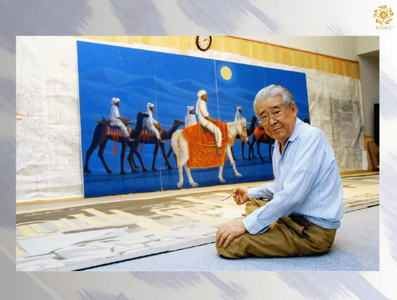Sergey Lapteff is a special researcher at the Miho Museum in Japan, a member of the Board of the World Society for the Preservation, Study and Popularization of the Cultural Legacy of Uzbekistan, the author and curator of the book-album The Cultural Legacy of Uzbekistan in the Collections of Japan, as well as forthcoming publications on rarities of the cultural heritage of Central Asia in the collections of the United Arab Emirates, China and the Republic of Korea.

In an interview, Lapteff confessed his love for the Silk Road and said that before it there were at least two conditional trade routes from East Asia to the Mediterranean, as well as shared how he got acquainted with the Cultural Legacy of Uzbekistan in the World Collections project.
Love for Japanese culture began before birth
My mother studied the Japanese language and Japanese culture when she was pregnant with me. It must have had a big impact on me, even before I was born. My mother also dreamed of becoming an archaeologist, but it did not work out. I realized her dream - I graduated from Moscow State University with a degree in archaeology, and after some time I went to Japan. Before the pandemic, I worked as a field archaeologist - doing excavations, restoration, and comparative archaeological research, which led me to the Silk Road. Now this is the main circle of my interests and the main love.

How are Japan and Uzbekistan connected?
In the territory of Uzbekistan, there were an ancient people - the Sogdians, who were very active in trading along the Silk Road. In many ways, my teacher, the outstanding archaeologist Edvard Vasilyevich Rtveladze, told me about this scientific and historical aspect. He wrote a lot about the Sogdians, their role in the cultural and trade exchange between countries. Indeed, the Sogdians were active not only on the caravan routes, but also on the sea, and things related to the Sogdians appeared in Nara already in the 7th century. An interesting story is the Sogdian named An Ye Ho, who was the founder of the Todai-ji temple in Japan, in the city of Nara. The temple is considered the largest wooden structure in the world and is protected as a UNESCO World Heritage Site. In the treasury of the temple - Shosoin, there are many unique items related to Sogdian culture
The Lapis Lazuli Belt as a Precursor of the Silk Road
One of the museum exhibits of the Shosoin treasury is the famous belt decorated with lapis lazuli. The birthplace of lapis lazuli was Central Asia, the city of Badakhshan. This place was the only one in the world where lapis lazuli was mined. This rare mineral played a huge role in the formation of statehood, not only in Central Asia, but also in the Middle East in Egypt and Mesopotamia. The belt is clear evidence that lapis lazuli reached Japan. It was highly valued in antiquity and became an object of prestige that rulers sought to acquire. I believe that the lapis lazuli road is the predecessor, the first stage of the Silk Road.

Glass road
The Shosoin imperial treasury keeps glass vessels from the Kushan Empire. I believe that the second stage of the Silk Road is the glass road. And then, gradually, silk appeared. Glass appeared around the 4th century. And at first the glass was not transparent and it was blue. Why blue? It was an imitation of lapis lazuli. That is why both Egyptian and cuneiform texts from Mesopotamia say that glass is called “lapis lazuli made by man” or “lapis lazuli from the city”, that is, lapis lazuli was such a valuable and expensive mineral that artificial imitations began to be made. This was the first glass. At first, these were small items such as beads. Then they began to make vessels from glass, and glass eventually becomes transparent, as we know it.
Acquaintance with the Cultural Legacy of Uzbekistan in the World Collections
Edvard Vasilyevich Rtveladze invited me to the project. When I was in Tashkent, he said: “There will be a congress, and if you have time, come and participate.” I arrived and met Firdavs Fridurnovich Abdukhalikov, the creator of the project. And somehow we immediately got along very well in character, and I began to help the project to the best of my modest strength and ability.
At the moment, one volume The Cultural Legacy of Central Asia in the Museums of Japan has been published. And I must say that this volume is not easy, but special. The fact is that the preface to it was written by President Shavkat Miromonovich Mirziyoyev. We presented the book at a major event - an international media event in Tokyo, at the Imperial Hotel, just the day before the arrival of Shavkat Mironovich Mirziyoyev in Japan. This was his first visit to the country.

The general sponsor of the project "Cultural legacy of Uzbekistan in the world collections" is the oilfield services company "Eriell Group"


